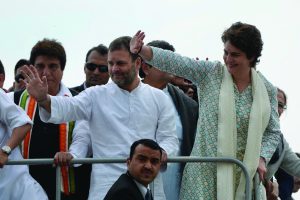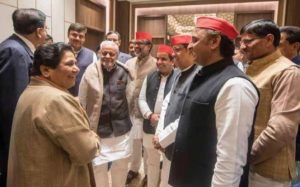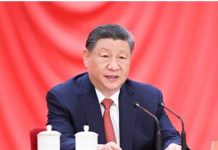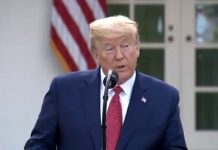 It is natural for the ruling Bhartiya Janata Party (BJP) and the non-Congress oppositions outfits to pause, rethink and revise their poll calculations following the surprise entry of Priyanka Gandhi in active politics, just a few months before the Lok Sabha elections. In spite of being the daughter of India’s first family, the legendary Nehru-Indira Gandhi and followed by Rajiv Gandhi, she has taken up a non-descript position of general secretary in the UP state unit of the Indian National Congress (INC).
It is natural for the ruling Bhartiya Janata Party (BJP) and the non-Congress oppositions outfits to pause, rethink and revise their poll calculations following the surprise entry of Priyanka Gandhi in active politics, just a few months before the Lok Sabha elections. In spite of being the daughter of India’s first family, the legendary Nehru-Indira Gandhi and followed by Rajiv Gandhi, she has taken up a non-descript position of general secretary in the UP state unit of the Indian National Congress (INC).
For her admirers, she resembles Indira Gandhi, who had led India during the tumultuous Bangladesh crisis in 1971. Her father Rajiv is admired for injecting information technology and upgrading the country’s communication systems amidst criticism both from the right wing, BJP, and the left parties. Both Indira Gandhi and Rajiv were martyred. The ultimate sacrifices of her family blended with her polite, but regal poise, Priyanka, is feared by all the non-Congress political outfits across the country as a great vote catcher.
The INC’s master-move with a surprise element could not have been better timed. She arrives on the political scene immediately after the clear victory of the party in the three states, Chhattisgarh, Madhya Pradesh and Rajasthan. Many believe that since Rahul has already proved his leadership in the recently held polls, Priyanka should not join the active politics.
 The INC could have reconciled in the much trumpeted alliance between Akhilesh Yadav’s Samajwadi Party (SP) and Mayawati’s Bahujan Samajwadi Party (BSP) with a third position, but it had to distance itself amidst the reports that it may be given only three-four seats in the 80-strong Lok Sabha seats in Uttar Pradesh. With Priyanka leading the campaign for the INC, many predict it may trigger off an avalanche giving huge number of seats to the party, which used to dominate the politics of the state.
The INC could have reconciled in the much trumpeted alliance between Akhilesh Yadav’s Samajwadi Party (SP) and Mayawati’s Bahujan Samajwadi Party (BSP) with a third position, but it had to distance itself amidst the reports that it may be given only three-four seats in the 80-strong Lok Sabha seats in Uttar Pradesh. With Priyanka leading the campaign for the INC, many predict it may trigger off an avalanche giving huge number of seats to the party, which used to dominate the politics of the state.
The electoral impact of this in the forthcoming polls is yet to be calculated, but her entry has not only upset the BJP, it has sent shocking waves among the non-BJP and the non-Congress political parties. The BJP concern is natural, because it has failed to win its two strongholds of Chattisgarh and Madhya Pradesh, where the INC lacked strong political organization. In the case of Rajashtan, BJP apologists assert that the electorates change the government in every five years. However, in private conversation they concede the waning of the Modi charisma. There is also disenchantment among the volunteers of Rashtriya Swayam Sewak Sangh (RSS). The party debacle is also attributed to the neutral role of the senior party leaders comprising L.K. Advani and Murli Manohar Joshi. If some hush-hush talks could be believed, even the three states where BJP suffered political debacle, a large number of the distraught RSS volunteers did not campaign in support of the BJP.
Priyanka’s arrival on the national scene accompanied by Prime Minister Narendra Modi’s refusal to concede the demand to rebuild the Ram temple in Ayodhya through an ordinance route bypassing the on-going Supreme Court hearing has shifted the electoral agenda to the development and economic issues. However, the on-going hearing before the Supreme Court is being keenly followed. Even if the hearing is completed before the elections, it is difficult to predict the final order of the apex court or whether it will be pronounced before the polls.
A 574-page Archeological Survey of India or ASI report consisting of written opinions and maps and drawings were submitted in a sealed envelope before the full Lucknow bench of the Allahabad High Court, which was later made public, but Muslim Personal Law Board and Babri Mosque Action Committee rejected that a temple existed before the Mir Baqui had erected the mosque. It had disclosed that there was archaeological evidence of a massive structure just below the disputed structure and evidence of continuity in structural activities
from the 10th century onwards up to the construction of the disputed structure.
The dispute has psychological issue being faced by the Hindus and Muslims. It is true that if left to themselves both Hindus and Muslims could have resolved the ticklish temple-mosque dispute of Ayodhya, but the political agenda for electoral gains has kept it alive all these years. An agreement was almost arrived in late nineties, but the then RSS chief rejected the initiative of the Vishwa Hindu Parishad, claims Shitla Singh , a veteran journalist from Ayodhya. Unfortunately, the RSS decided to follow the colonial narrative of the history of Indian sub-continent that promoted an idea that the Hindus suffered Muslim repression for 900 years. Similarly, Muslims fed with the theme that Holy Koran inspired them to conquer Hindus, the infidels.
In this era of competitive politics, where the rivals are pitted against with each other, have adopted no-holds bar approach, but in this process they are endorsing the colonial narrative that the Hindus were tormented during the reigns of Muslims kings and emperors, and it also fed the Muslim masses that they have been ruling India for a millennium and Hindus are just cowards. The colonial narrative of the Indian past has been presented as the British restored the Hindu honour, which suffered and violated by the Muslim invaders. Therefore, Hindus must realize that the British have emancipated them from the Muslim tyranny. On the other hand, Islam was used in such a conspiring agenda that the civil society among Muslims succumbed to the much pronounced logic that Islam is in danger.
The twin strategy of colonial era, thus convincing Hindus that they suffered Muslim tyranny, and also projecting followers of Islam as an aggressive group, which got partitioned India in 1947, and will reassert when its population is adequate to oust Hindus. Both journalists and practicing politicians must trace India’s social-political challenges to the British historiography. Charles Napier, the British General, deposed the Talpur Mirs, in Sind in 1843. He described the Sindh rulers as great ruffians and imbeciles, who possessed zennanas filled with young girls torn from their friends and treated the women with revolting barbaric insult of 800 years…”.
Further, Edward Ellenborough, the then Governor General of India, dramatically brought back the “gates of Somnath temple” from Kabul to show that the company was there to counter the Muslim tyranny. He even claimed that the return of the spoiled remains of the temple to India has avenged the insult of Hindus”. Even today, a large number of the Hindu intellectuals, including RSS and BJP leaders subscribe to this theory. Unfortunately, the Indian historians trained at the Universities of Calcutta, Aligarh, Baroda and Osmania have not cared to expose this mischief of the colonial rulers.
Initiative endorsement
India’s two epics, Ramayana and Mahabharata, were telecast on the national television channel Doordarshan, during the Rajiv Gandhi reign. They received worldwide attention, but the BJP-led NDA governments headed by Atal Bihari Vajpeyi and Narendra Modi, could not produce any such television serial based on Indian mythology, though Vajpeyi ruled for six years and Modi is now at the verge of completing his five-year tenure.
A section of academia having science and technology backgrounds has offered a temple comprising the spiritual components of all faiths. The initiative has been taken by a group of academia comprising Hindus and Muslims, who have been working for making spiritualism a component of scientific researches. With their successes in this pursuit, they have now emboldened to resolve the tackling the perennial temple-mosque dispute in Ayodhya.
It is a non-political secular initiative comprising former Nagpur University vice-chancellor S.N. Pathan and Pune-based Dr. Vishwanath Karad, the courageous founder of the Maharashtra Institute of Technology, MIT. They had submitted a proposal to Dr. Manmohan Singh during his tenure as the Prime Minister, has embarked upon their mission. It remained a non-starter, though they held a number of meetings from Ayodhya to Pune.
These enlightened sections hope that Priyanka may finally end this controversial issue, if she is convinced that the Pune experiment of constructing a huge place of worship, the temple of harmony, may be replicated in Ayodhya.
Karad’s experiment to blend spiritualism with science for the past more than two decades awaits political endorsement. He is convinced that the science reflects the human yearning to know the Unknown. The religions too were complementing this quest with spiritualism. He and his team comprising many eminent people of academia, including Dr. Vijay Bhatkar, a well-known computer scientist, Maulana Wahidulla Khan Ansari, an Islamic scholar, and many others are actively campaigning for a temple of harmony. They point out that the huge land already with the Union government in Ayodhya should take the initiative for the temple construction. The apex court may allow this initiative.
These enthusiasts have already succeeded in reconstructing a temple of Lord Rama at Rui (Rameshwar) with the help of local villagers, comprising Hindus, Muslims, Buddhists and many others. The temple was destroyed by the invading forces of Nizam 275 years ago. Similarly, an aggressive mob of Hindu zealots had destroyed the Jumma Masjid and the Khawaja Zainuddin Dargah in 1940 too has been restored to become a centre of pilgrimage for every one irrespective of their faiths as a Temple of Harmony. In this context, the teachings of India’s great saints, Dnyaneshwara, Tukaram and Vivekananda guide us to the right path through spiritualism.
The Christian card
Priyanka’s critic may take up the issue that she is married to a Christian, Robert Vadra, but it may not be able to adversely impact on her political career. Her marriage was solemnized by a Kashmiri Pundit, Iqbal KIshen, the grandson of Pundit Shamlal. Shamlal was the high priest of Jawaharlal Nehru’s marriage with Kamla. Similarly, Indira Gandhi’s marriage with Feroze Gandhi amidst chanting of Vedic hymns had taken place under the supervision of Pundit Laxmi Dhar, a well-known Sanskrit scholar.
Asked why this traditional Kashmiri pundit wedding was never publicised, RC Ganju, a senior journalist asserts that the family has always kept these personal engagements as private affairs. A lot of malicious campaign against them is in the social media, but the family never responds to the wild allegations. Maybe, they are convinced that the people would never believe in such campaigns against them.
A Congress insider confides that the BJP-RSS propaganda, in fact, re-invigorates them politically. The prolonged malicious personal propaganda has enabled both Rahul and Priyanka to occupy the centre-stage of the campaign for 2019 Lok Sabha polls. In this backdrop, Priyanka’s arrival on the political scene unleashes new prospects for the INC in UP, where its existence is negligible, but has a rich past.
letters@tehelka.com














